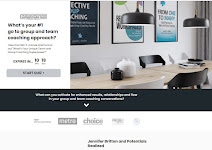Guest blog post for Group Coaching Ins & Outs
Submitted by Jennifer Bradley
www.jenniferbradleyphd.com
------------------------------
If you coach groups or teams it is very likely that you will have individuals from different cultural backgrounds as coachees. Have you considered your personal cultural identity? Most interculturalists contend that an in-depth understanding of your own culture is the foundation of your ability to work effectively with diverse groups.
I invite you to try the exercise below as a way of exploring how culture has shaped your identity today. This exercise, adapted from the work of psychologist Larke Nahme Huang, asks you to consider both how you see yourself (personal internal identity) and your views on how others see you (social external identity). Answer the questions below to explore these two different dimensions of cultural identity.
1. (a) Make a list the groups that you belong to that you feel have shaped who you are today.
Examples might be groups based on nationality, ethnicity, language use, religion, politics, region, or socioeconomic group. Select those groups that you feel have been most significant to to you personally.
1 (b) Extend your list by adding other groups, roles, or attributes that you feel have been or are important to how you see yourself. Examples might be family (sibling, son or daughter, parent, partner, spouse, etc.), profession, gender, age, health status, or role in your community.
1 (c) Different attributes may be salient at different times and in different contexts. For instance, if you are bilingual but now live in a community this is largely monolingual, being bilingual may be more salient if you experience this as a loss, or less salient because this aspect of your identity is in the background. It depends on your personal experience.
Review your list of responses to both (a) and (b), and mark the top 5 or 6 influences that seem most relevant to you today. Your answers to question 1 gives you information on your personal internal identity.
2. Next, think about how others might perceive you. For example, as a coach beginning work with a new group, what do you think is most salient to group members as they figure out who you are? What sources of information are they most likely to rely on to construct your identity?
Examples might be physical attributes such as skin color, appearance, gender, age, language use and accent, group memberships, professional, and community roles. This list gives you information about your social external identity in the context you have chosen.
3. Now compare the dimensions of how you see yourself (internal identity) with how you perceive that others see you (external identity).
What similarities and differences do you notice?
What aspects of your internal and external identity are congruent or dissonant?
Which aspects do you experience positively or negatively?
In his book, Coaching across Cultures, [link: http://www.coachingacrosscultures.com]
Philippe Rosinski argues that by leveraging cultural differences coaches expand the options available and improve coaching outcomes.
What new opportunities have you identified based on this exploration of your cultural identity? Share your thoughts and feedback below.
About the author:
Jennifer Bradley, Ph.D. helps mid-career professionals and expatriates craft a work-life environment where they can flourish both personally and professionally. She is a Registered Occupational Psychologist (U.K.) and Accredited Coach (ICF). She holds a Doctorate from the University of Manchester (U.K.) and a Masters Degree in Intercultural Relations (University of the Pacific, CA). She currently resides in Dallas, TX. She can be reached at http://www.jenniferbradleyphd.com.
Subscribe to:
Post Comments (Atom)












No comments:
Post a Comment